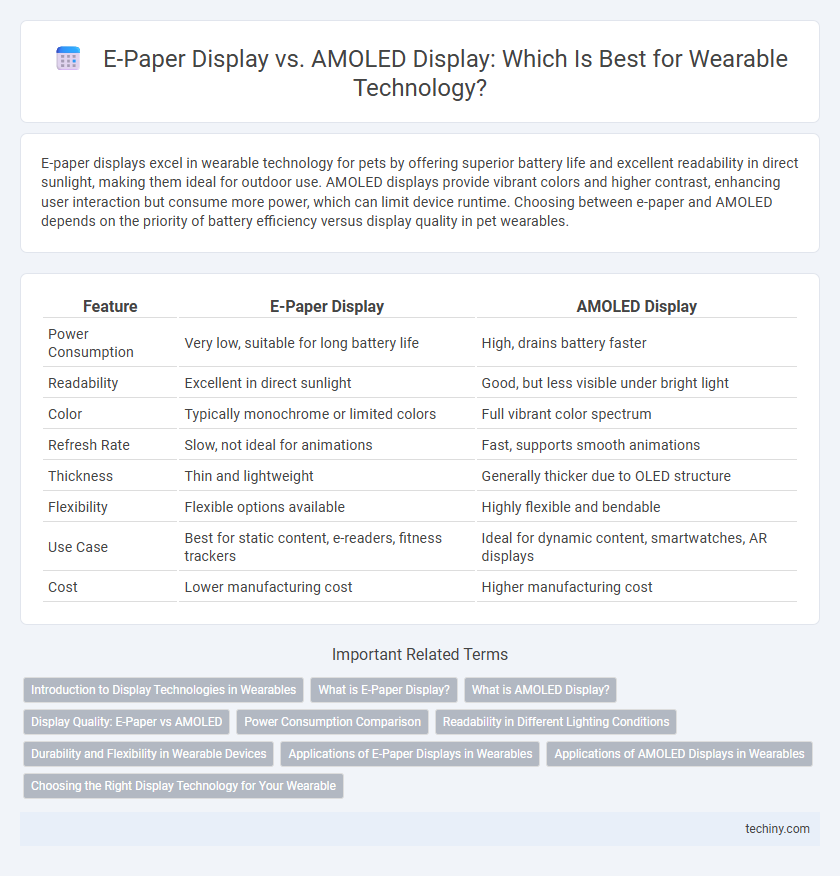E-paper displays excel in wearable technology for pets by offering superior battery life and excellent readability in direct sunlight, making them ideal for outdoor use. AMOLED displays provide vibrant colors and higher contrast, enhancing user interaction but consume more power, which can limit device runtime. Choosing between e-paper and AMOLED depends on the priority of battery efficiency versus display quality in pet wearables.
Table of Comparison
| Feature | E-Paper Display | AMOLED Display |
|---|---|---|
| Power Consumption | Very low, suitable for long battery life | High, drains battery faster |
| Readability | Excellent in direct sunlight | Good, but less visible under bright light |
| Color | Typically monochrome or limited colors | Full vibrant color spectrum |
| Refresh Rate | Slow, not ideal for animations | Fast, supports smooth animations |
| Thickness | Thin and lightweight | Generally thicker due to OLED structure |
| Flexibility | Flexible options available | Highly flexible and bendable |
| Use Case | Best for static content, e-readers, fitness trackers | Ideal for dynamic content, smartwatches, AR displays |
| Cost | Lower manufacturing cost | Higher manufacturing cost |
Introduction to Display Technologies in Wearables
E-paper displays in wearable technology offer ultra-low power consumption and excellent readability in bright sunlight, making them ideal for devices requiring extended battery life and outdoor use. AMOLED displays provide vibrant colors, deep blacks, and faster refresh rates, enhancing user experience with dynamic visuals and responsive touch interfaces. Choosing between e-paper and AMOLED hinges on balancing energy efficiency and display quality to meet specific wearable device requirements.
What is E-Paper Display?
E-paper displays use electronic ink to create images by manipulating charged pigment particles, offering ultra-low power consumption and excellent readability in direct sunlight. Unlike AMOLED displays, e-paper screens maintain their image without constant power, making them ideal for wearable devices requiring long battery life. Their reflective nature and high visibility in outdoor conditions enhance user experience in fitness trackers and smartwatches designed for prolonged use.
What is AMOLED Display?
AMOLED display, or Active Matrix Organic Light Emitting Diode, is a cutting-edge screen technology widely used in wearable technology for its vibrant color reproduction and energy efficiency. Each pixel in an AMOLED display emits its own light, eliminating the need for a backlight and enabling deeper blacks and higher contrast ratios compared to E-Paper displays. This technology supports flexible and lightweight designs, making it ideal for smartwatches and fitness trackers that require vivid visuals and extended battery life.
Display Quality: E-Paper vs AMOLED
E-Paper displays offer superior readability in bright sunlight and consume significantly less power, making them ideal for always-on wearable devices. AMOLED displays deliver vibrant colors, deeper blacks, and higher contrast ratios, providing a more immersive visual experience for multimedia use. Both display types optimize user experience by balancing battery efficiency and visual quality depending on application demands.
Power Consumption Comparison
E-paper displays consume significantly less power than AMOLED displays due to their reflective technology, which only uses energy when updating the screen, making them ideal for devices requiring extended battery life. AMOLED displays, while offering vibrant colors and higher brightness, continuously draw power to maintain image refresh and backlight, leading to greater energy consumption. In wearable technology, e-paper's efficient power usage translates to longer operational times between charges, whereas AMOLED's power demands prioritize visual performance over battery longevity.
Readability in Different Lighting Conditions
E-paper displays excel in readability under direct sunlight and bright outdoor environments due to their reflective nature, minimizing glare and providing a paper-like reading experience. AMOLED displays offer vibrant colors and high contrast, making them ideal for low-light and indoor conditions but often suffer from reduced visibility and increased glare in strong ambient light. Choosing between e-paper and AMOLED for wearable technology depends heavily on the primary lighting conditions users expect, balancing outdoor readability with dynamic color performance.
Durability and Flexibility in Wearable Devices
E-Paper displays offer superior durability and flexibility, making them ideal for wearable devices subjected to constant bending and outdoor exposure due to their low power consumption and resilience to sunlight. AMOLED displays provide vibrant colors and high contrast but are more susceptible to screen burn-in and physical damage from impact or prolonged bending. Choosing between E-Paper and AMOLED hinges on balancing flexible durability with dynamic visual performance in wearable technology.
Applications of E-Paper Displays in Wearables
E-Paper displays in wearable technology excel in low power consumption and high visibility under direct sunlight, making them ideal for fitness trackers and smartwatches designed for outdoor use. Their bistable nature allows screens to retain images without constant power, significantly extending battery life in devices like medical monitors and e-readers integrated into wearable form factors. E-Paper technology also supports flexible and lightweight designs, enhancing comfort and durability for long-term wearable applications.
Applications of AMOLED Displays in Wearables
AMOLED displays in wearable technology offer superior color accuracy, deep blacks, and high contrast ratios, enhancing user experience in devices like smartwatches and fitness trackers. Their flexible and energy-efficient nature enables lightweight, curved designs that improve comfort and battery life for continuous health monitoring and notifications. These qualities make AMOLED panels ideal for wearables requiring vibrant visuals and prolonged usage without frequent charging.
Choosing the Right Display Technology for Your Wearable
E-Paper displays offer exceptional power efficiency and readability in direct sunlight, making them ideal for fitness trackers and smartwatches prioritizing battery life and outdoor use. AMOLED displays deliver vibrant colors, deeper blacks, and faster refresh rates, enhancing user experience in smartwatches featuring rich multimedia and interactive interfaces. Selecting the right display technology depends on balancing energy consumption, ambient visibility, and visual performance requirements tailored to specific wearable applications.
E-Paper Display vs AMOLED Display Infographic

 techiny.com
techiny.com